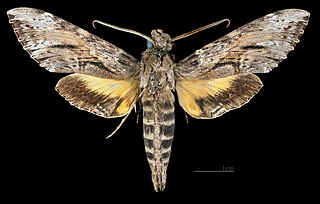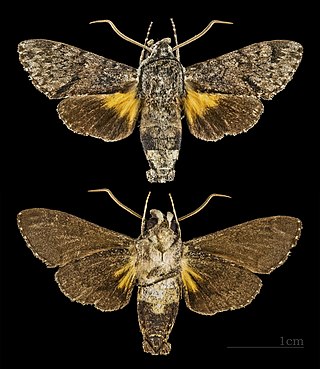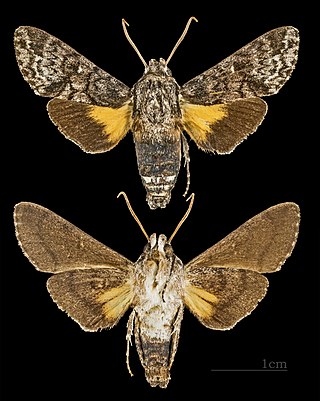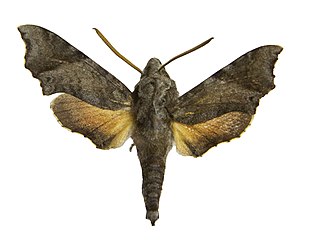
Callionima nomius, the fan-tailed bark moth, is a moth of the family Sphingidae. The species was first described by Francis Walker in 1856.

Isognathus rimosa, the rimosus sphinx, is a moth of the family Sphingidae. The species was first described by Augustus Radcliffe Grote in 1865.

Cautethia spuria, the spurious sphinx, is a moth of the family Sphingidae. The species was first described by Jean Baptiste Boisduval in 1875. It lives from Mexico to Costa Rica to southern Texas and Oklahoma on the North American continent.

Eumorpha anchemolus, the anchemola sphinx moth, is a moth of the family Sphingidae. The species was first described by Pieter Cramer in 1780.

Eumorpha intermedia, the intermediate sphinx, is a moth of the family Sphingidae. The species was first described by Benjamin Preston Clark in 1917. It lives in the US states of North Carolina, Florida, Mississippi, Louisiana, and southern Texas.

Proserpinus clarkiae, or Clark's sphinx, is a moth of the family Sphingidae. The species was first described by Jean Baptiste Boisduval in 1852. It is known from British Columbia and Washington south through California to Baja California, east to Idaho, Wyoming and Utah. The habitat consists of oak woodland and pine-oak woodland in foothills.

Xylophanes eumedon is a moth of the family Sphingidae. It is known from Mexico.

Hippotion saclavorum is a moth of the family Sphingidae. It is known from Madagascar, In the town of Ambinanindrano, 50km west of Mahanoro.

Macroglossum dohertyi is a moth of the family Sphingidae. It is known from Queensland and Papua New Guinea.

Cautethia is a genus of moths in the family Sphingidae first described by Augustus Radcliffe Grote in 1867.

Lophostethus dumolinii is a moth of the family Sphingidae. It is known from most habitats, except desert and high mountains throughout the Ethiopian Region, excluding Madagascar and the Cape in South Africa.

Temnora inornatum is a moth of the family Sphingidae. It is known from South Africa.

Temnora avinoffi is a moth of the family Sphingidae. It is known from Nigeria to Cameroon and Gabon.

Temnora pylades is a moth of the family Sphingidae. It is known from Uganda, Kenya, Tanzania and Malawi.

Callionima ramsdeni is a species of moth in the family Sphingidae which is known from Cuba. It was originally described by Benjamin Preston Clark in 1920.

Cautethia exuma is a species of moth in the family Sphingidae, which is known from the Bahamas. It was described by Timothy L. McCabe in 1984.

Proserpinus vega, the vega sphinx moth, is a moth of the family Sphingidae. The species was first described by Harrison Gray Dyar Jr. in 1903. It is found from southern Arizona, New Mexico and Texas south into Mexico.

Euproserpinus phaeton, the Phaeton primrose sphinx moth, is a moth of the family Sphingidae. the species was first described by Augustus Radcliffe Grote and Herbert C. Robinson in 1865. It is found in North America from California south to Baja California Sur and further into Mexico. It has also been reported in south-western Arizona.

Oryba achemenides is a moth of the family Sphingidae.

Adhemarius eurysthenes is a species of moth in the family Sphingidae. It was described by Rudolf Felder in 1874, and is known from Brazil, Colombia and Paraguay.





















